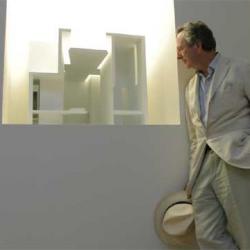The Famous Spanish Architect Rafael Moneo in Old Havana
- Submitted by: admin
- Arts and Culture
- Caribbean
- culture an traditions
- Destinations
- Education
- Europe
- Havana
- international
- Society
- Spain
- 07 / 11 / 2008

Moneo went around the Historical Center of Havana being personally guided by the Historian of the City, Doctor Eusebio Leal Spengler.
It would be “a monument to contemporary architecture,” suggested Leal Spengler, when he commented the possibility of a project by Moneo in Havana.
José Rafael Moneo Vallés (Tudela, Navarra, 1937) is considered one of the most important contemporary architects, the recipient of many awards and decorations.
The author of the extension of the Prado Museum (Madrid) talked for about two hours in front of an auditorium made up by famous Cuban architects.
There were also dozens of young specialists, who crammed the ancient Saint Phillip Neri Oratory, which is currently a concert hall.
“There are very few cities that have established such an intimate relationship between the people who live in it and the city itself,” said Moneo.
Separately with the press, when he referred himself to the restoration work in Old Havana, he expressed that he felt favorably identified with it, “not so much with the material results but with the ambitious level of this global project.”
Moneo qualified its project from the Murcia City Hall (1991-1998) as a typical construction problem in a Historical center, with challenges that include visual conciliations among ancient Baroque facades and the irruption of a new building in the Cardenal Belluga Plaza.
Afterward he referred to the General Archives from the Navarra Kingdom, in Pamplona (1995-2003), in which he managed to turn “a rundown old house” into a new building where “Gothic structures may be seen.”
Lastly, he talked about his conceptions on the extension of the Prado Museum which “ended in 2007,” respecting the value of the building constructed by Juan de Villanueva in the 18th century as the Natural Sciences Department.
Among the most recent awards of the famous Spanish artist are the Award of Contemporary Architecture from the European Union (2001), the Gold Medal from the Royal Institute of British Architects (2003) and the Gold Medal of Architecture (CSCAE) in 2006.
In his curriculum there are also works such as the Roman Art National Museum in Merida (1980-1986) and the extension of the Atocha Station in Madrid (1985-1992). There were also the Juan Miró Foundation in Palma de Mallorca (1987-1992), the Modern Art and Architecture Museum from Stockholm (1994) and the Our Lady of Los Angeles Cathedral, California (1996-2002).
Havana, the capital of the Cuban Republic, is also known for its founding name of Villa de San Cristóbal de La Habana and the “City of Columns” as it was called by the famous Cuban writer Alejo Carpentier (1904-1980).
It was founded on November 16, 1519 by the Spanish conquistador Diego Velázquez de Cuéllar. Its old city, together with its fortifications was declared World Heritage Sites in 1982 by UNESCO.
(Cubarte)
Comments